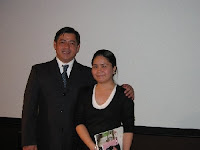 Once you’re a showbiz celebrity, you can easily get your way to politics. Popularidad. Ayon sa maraming kritiko, ito lamang ang tanging dahilan kung bakit nailuluklok sa panunungkulan sa pamahalaan ang mga aktor at aktres ng pinilakang-tabing.
Once you’re a showbiz celebrity, you can easily get your way to politics. Popularidad. Ayon sa maraming kritiko, ito lamang ang tanging dahilan kung bakit nailuluklok sa panunungkulan sa pamahalaan ang mga aktor at aktres ng pinilakang-tabing.“Popularity is an advantage but it also has its downside. Our advantage is that people know a lot about us but the disadvantage is that our mistakes are magnified and noticed,” saad naman ng isang actress turned politician.
Kung ating babalikan, bago ang dekada saisenta (60’s), ang tanging aktor na matagumpay na naihalal sa public office ay ang sikat na matinee idol na si Rogelio dela Rosa bilang senador noong 1957. Makalipas ang apat na taon na panunungkulan, siya’y kumandidato bilang independent candidate para pangulo kalaban sina re-electionist Carlos P. Garcia ng Nacionalista Party at top-notch lawyer-congressman Diosdado Macapagal ng Liberal Party. Ngunit ilang araw bago ang eleksyon, umatras sa laban si dela Rosa dahil sa kakulangan ng pondo at makinarya at pagbibigay daan na rin sa ambisyon ng kanyang bayaw at kababatang si Macapagal na siyang nanalong presidente.
Makalipas ang tatlumpung taon, muling binuhay ni Joseph ‘Erap’ Estrada ang naging papel ni dela Rosa sa senado nang siya ay maging senador noong 1987, matapos ang mahabang panunungkulan sa bayan ng San Juan bilang alkalde. Naging bise-presidente at presidente ng Pilipinas, nakita natin ang pagbagsak ng political career ni Erap. Ngunit sa kabila nito, siya at hindi si dela Rosa ang naging modelo ng mga artistang sumabak sa teatro ng pulitika.
Hindi rin makakalimutan ang naging kapalaran ng Hari ng Pelikulang Pilipino, ang pumanaw na si Fernando Poe Jr. nang siya ay kumandidato para pangulo noong 2004. Si ‘Da King’ ang naging pinakamahigpit nakatunggali ni PGMA. Samu’t saring kontrobersiya sa pulitika at maging sa showbiz industry ang naglabasan na naging dahilan din ng pagkakahati-hati ng mga artista dahil sa magkakaibang pananaw.
Sa pag-usad ng mga taon, patuloy na dumami ang bilang ng mga artistang naghangad magkaroon ng top-billing sa public office. Ang iba ay nabigyan ng pagkakataon samantalang ang iba nama’y hanggang pag-asa na lamang. Kabilang sa listahan ay sina Ramon Revilla Sr., Tito Sotto, Lito Lapid, Bong Revilla Jr., Jinggoy Estrada, Vilma Santos, Aiko Melendez, Dan Fernandez, Teri Onor, Herbert Bautista, Marjorie Barreto, Joey Marquez, Alma Moreno, AnjoYllana, Lani Mercado, Rey Malonzo, Cita Astals, Isko Moreno, Robert Ortega, Lou Veloso, Richard Gomez, Cesar Montano, Victor Wood, Imelda Papin, Gary Estrada, Roderick Paulate, Rudy Fernandez, Tirso Cruz III, Elizabeth Oropesa, Cristina Gonzales, Lani Mercado, Philip Salvador, Aga Muhlach, Andrew E., Jestoni Alarcon, Arnel Ignacio, Diether Ocampo, Kuh Ledesma, Jeffrey Santos, Dan Fernandez, Nadia Montenegro at Christopher de Leon.
Hanggang sa katatapos na national at local elections noong Mayo, dumagsa pa rin ang bilang ng mga artistang kumandidato. Ngunit majority sa kanila ay hindi nabigyan ng katuparan ang kanilang mga pangarap. Ito ba ay isang patunay na wala nang kinang ang mga bituin na kanilang taglay?
Sa tuwina’y kinukuwestiyon ang kakayahan ng isang artista na magsilbi sa taong-bayan. Ngunit kung ating pagbabatayan ang kwalipikasyon ng COMELEC na nagsasabing, “Any individual can run for public office for as long as he or she can read and write, is a Filipino citizen, and is a resident of the area where he or she hopes to get elected,” masasabing legally qualified ang mga artista para sa isang elective post.
Ang mga artista ay mamamayan din ng Pilipinas nanararapat na maging bahagi sa pagbuo ng bansa. Katulad ng ordinaryong tao, mayroon din silang responsibilidad bilang isang Pilipino.
“The arts and media are the transmitters of culture. Artists play an important and unique role in the transformation of culture that is responsive to the need of the people towards a truly independent and progressive Philippine nation,” sabi nga ng isang cultural activist.
Nararapat ba nating ipagkatiwala ang ating hinaharap samga iniidolo nating movie at TV personalities? Kung ang kanila bang prinsipyo ay iyong sa interes ng nakararaming Pilipino at kung kapakanan ng bansa at ikabubuti nito ang kanilang mithiin, bakit hindi? Hindi dapat magkaroon ng diskriminasyon laban sa mga artistang nagnanais maglingkod sa bayan. Ating pagbasehan ang kanilang kwalipikasyon at track record. Hangga’t nararamdaman nila na may kakayahan silang ibahagi ang kanilang mga sarili para sa kapakanan ng bansa at ng taong-bayan, let’s give them a fair chance!
*published in the July '07 issue of "Beyond the Horizon", Philippine Digest*




















